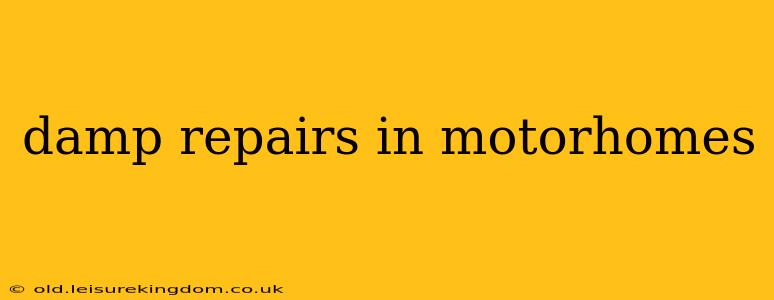Dealing with damp in your motorhome can be a nightmare, but understanding the causes and effective repair methods can save you significant stress and expense. This comprehensive guide explores everything you need to know about damp repairs in motorhomes, from identifying the source of the problem to choosing the right repair techniques.
What Causes Damp in Motorhomes?
Dampness in motorhomes stems from a variety of sources, often interacting to create a complex problem. Understanding these sources is crucial for effective repair.
- Leaking Roofs: This is the most common culprit. Cracks, poorly sealed seams, damaged roof vents, or even just a buildup of debris blocking drainage can lead to significant water ingress.
- Window and Door Seals: Worn or damaged seals around windows and doors allow rainwater to seep inside. This is often overlooked but can be a significant source of damp.
- Plumbing Leaks: Leaks in pipes, tanks, or fittings can cause hidden dampness, often manifesting in unexpected areas. Regular checks of your plumbing system are vital.
- Condensation: This is particularly problematic in colder months. Moisture in the air condenses on cold surfaces, leading to dampness and the growth of mold. Proper ventilation is key to mitigating this.
- Poor Ventilation: Inadequate ventilation traps moisture within the motorhome, creating a breeding ground for mold and dampness.
How to Find the Source of Damp in Your Motorhome?
Locating the source of damp is the most critical step in repair. Here’s how to approach it systematically:
- Visual Inspection: Carefully examine the exterior of your motorhome for any visible signs of leaks, cracks, or damaged seals around windows, doors, and roof fixtures.
- Interior Check: Look for signs of water staining, bubbling wallpaper, or a musty smell. Pay close attention to areas near windows, doors, and plumbing fixtures.
- Moisture Meter: Use a moisture meter to pinpoint areas with high moisture levels. This tool can help you locate hidden dampness behind walls or in other hard-to-reach places.
- Professional Inspection: For complex cases, consider a professional damp-proofing specialist who can use more advanced techniques to identify the source of the problem.
What is the best way to prevent dampness in a motorhome?
Preventing dampness is far easier and cheaper than dealing with the consequences. Regular maintenance is key. This includes:
- Regular Roof Inspections: Inspect your roof regularly for any cracks, damage, or debris buildup.
- Sealing: Ensure all seals around windows, doors, and roof fixtures are in good condition and reseal as needed.
- Ventilation: Ensure adequate ventilation, especially in colder months. Use vents and fans to circulate air and prevent moisture buildup.
- Plumbing Checks: Regularly check your plumbing system for any leaks or signs of damage.
What are the common signs of damp in a motorhome?
Common signs of damp in a motorhome include:
- Visible water stains on walls or ceilings.
- Bubbling or peeling wallpaper.
- A musty or moldy smell.
- Soft or spongy areas on walls or floors.
- Mold or mildew growth.
How much does damp repair in a motorhome cost?
The cost of damp repair in a motorhome can vary greatly depending on the extent of the damage and the complexity of the repair. Minor repairs, such as resealing a window, might cost a few hundred dollars, while extensive repairs involving structural work could cost thousands.
How long does it take to repair damp in a motorhome?
The time required for damp repair depends on the extent of the damage and the complexity of the repair. Minor repairs might take a few hours, while extensive repairs could take several days or even weeks.
Repairing Damp in Your Motorhome
Once you've identified the source, you can begin repairs. This might involve:
- Resealing: Repairing or replacing damaged seals around windows, doors, and roof fixtures.
- Replacing damaged panels: Removing and replacing water-damaged sections of the motorhome's structure. This often involves significant work and professional expertise.
- Plumbing repairs: Fixing leaking pipes or fittings.
- Treating mold and mildew: Using appropriate cleaning agents and anti-fungal treatments to eliminate mold and mildew growth.
- Improving ventilation: Installing better ventilation systems or adding extra vents to improve air circulation.
Important Note: For significant water damage, professional help is often necessary. Attempting complex repairs yourself without the proper skills and tools can lead to further damage and increased costs.
By understanding the causes of dampness, employing thorough inspection techniques, and utilizing appropriate repair methods, you can effectively address dampness issues in your motorhome, ensuring a comfortable and safe travel experience. Remember preventative maintenance is key!

